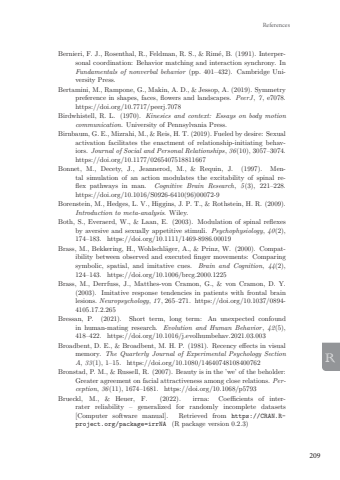Page 211 - Demo
P. 211
209ReferencesRBernieri, F. J., Rosenthal, R., Feldman, R. S., & Rimé, B. (1991). Interpersonal coordination: Behavior matching and interaction synchrony. InFundamentals of nonverbal behavior (pp. 401–432). Cambridge University Press.Bertamini, M., Rampone, G., Makin, A. D., & Jessop, A. (2019). Symmetrypreference in shapes, faces, flowers and landscapes. PeerJ, 7 , e7078.https://doi.org/10.7717/peerj.7078Birdwhistell, R. L. (1970). Kinesics and context: Essays on body motioncommunication. University of Pennsylvania Press.Birnbaum, G. E., Mizrahi, M., & Reis, H. T. (2019). Fueled by desire: Sexualactivation facilitates the enactment of relationship-initiating behaviors. Journal of Social and Personal Relationships, 36(10), 3057–3074.https://doi.org/10.1177/0265407518811667Bonnet, M., Decety, J., Jeannerod, M., & Requin, J. (1997). Mental simulation of an action modulates the excitability of spinal reflex pathways in man. Cognitive Brain Research, 5(3), 221–228.https://doi.org/10.1016/S0926-6410(96)00072-9Borenstein, M., Hedges, L. V., Higgins, J. P. T., & Rothstein, H. R. (2009).Introduction to meta-analysis. Wiley.Both, S., Everaerd, W., & Laan, E. (2003). Modulation of spinal reflexesby aversive and sexually appetitive stimuli. Psychophysiology, 40(2),174–183. https://doi.org/10.1111/1469-8986.00019Brass, M., Bekkering, H., Wohlschläger, A., & Prinz, W. (2000). Compatibility between observed and executed finger movements: Comparingsymbolic, spatial, and imitative cues. Brain and Cognition, 44(2),124–143. https://doi.org/10.1006/brcg.2000.1225Brass, M., Derrfuss, J., Matthes-von Cramon, G., & von Cramon, D. Y.(2003). Imitative response tendencies in patients with frontal brainlesions. Neuropsychology, 17 , 265–271. https://doi.org/10.1037/0894-4105.17.2.265Bressan, P. (2021). Short term, long term: An unexpected confoundin human-mating research. Evolution and Human Behavior, 42(5),418–422. https://doi.org/10.1016/j.evolhumbehav.2021.03.003Broadbent, D. E., & Broadbent, M. H. P. (1981). Recency effects in visualmemory. The Quarterly Journal of Experimental Psychology SectionA, 33(1), 1–15. https://doi.org/10.1080/14640748108400762Bronstad, P. M., & Russell, R. (2007). Beauty is in the ’we’ of the beholder:Greater agreement on facial attractiveness among close relations. Perception, 36(11), 1674–1681. https://doi.org/10.1068/p5793Brueckl, M., & Heuer, F. (2022). irrna: Coefficients of interrater reliability – generalized for randomly incomplete datasets[Computer software manual]. Retrieved from https://CRAN.Rproject.org/package=irrNA (R package version 0.2.3)Iliana Samara 17x24.indd 209 08-04-2024 16:37


